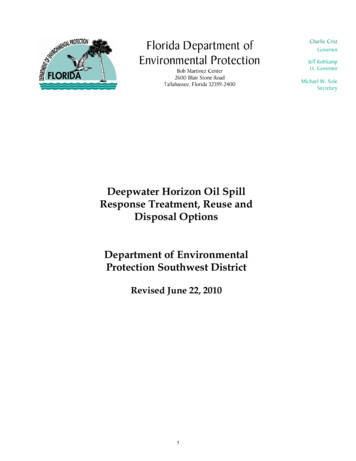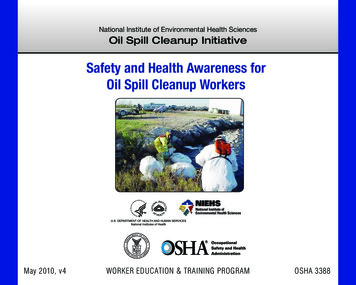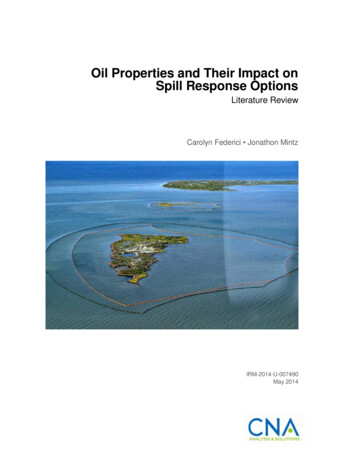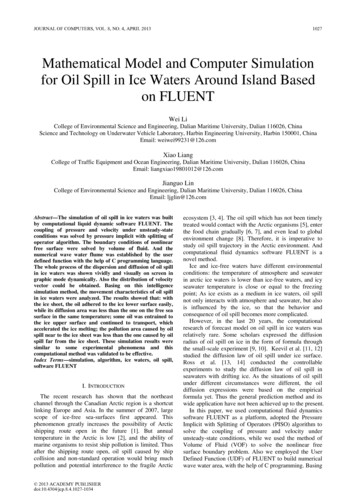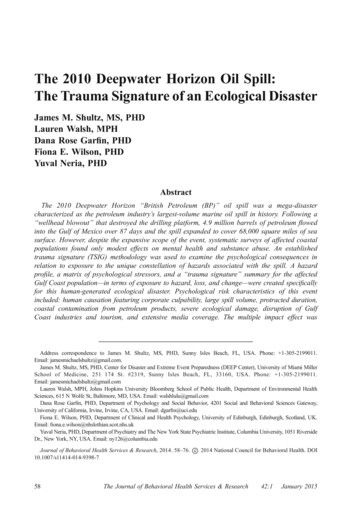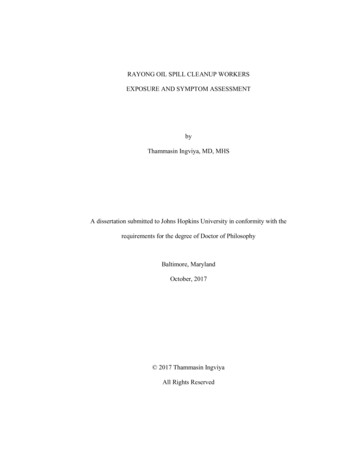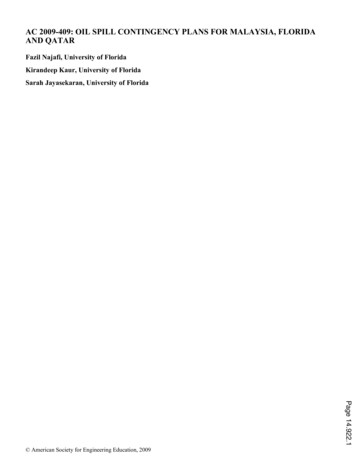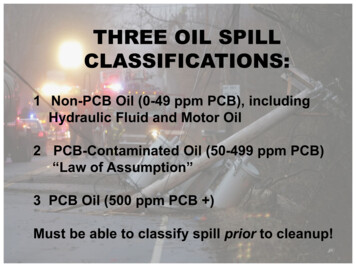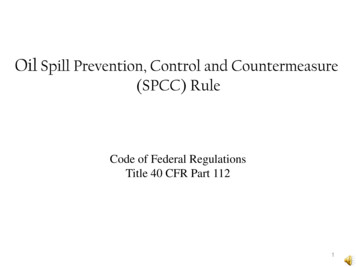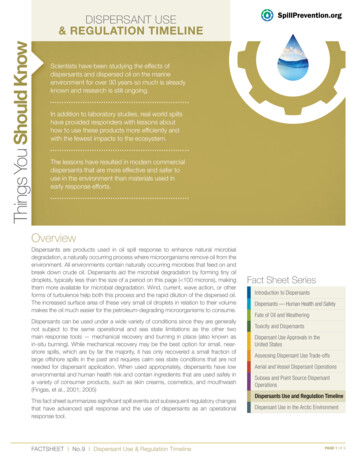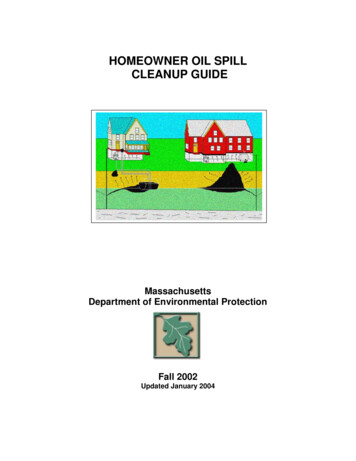
Transcription
HOMEOWNER OIL SPILLCLEANUP GUIDEMassachusettsDepartment of Environmental ProtectionFall 2002Updated January 2004
Homeowner Oil Spill Cleanup GuideFall 2002, Updated January 2004READ THIS HOMEOWNER OILSPILL CLEANUP GUIDEIF YOU ARE INTERESTED IN: Maintaining your property valueMinimizing the disruption to you and your familyProtecting against lawsuitsMinimizing your compliance feesMinimizing your cleanup costs by acting quicklyAddressing your problem before it gets worseComplying with Massachusetts environmental lawsBut most importantly Protecting your health, your drinking water and the environmentThis Guide provides you with the information you need to knowto clean up an oil spill properly. Tips to save time and money are alsoincluded.BE AWARE OF HIGH CLEANUP COSTSIn 2001, DEP conducted a survey of 510 homeowners who had experienced a home heatingsystem oil spill. Questions included how long the cleanup had taken, the costs involved, and whether soiland/or groundwater were affected. Cost data were provided by 159 homeowners.Costs were significantly lower when homeowners cleaned up spills quickly and prevented impactsto groundwater. Prompt cleanups also minimized disruption and reduced the potential for exposure offamily members or neighbors to the oil. Survey data indicated that spills that had time to spread togroundwater were significantly more expensive to clean up. Most cleanups completed in four months or less: 20,000 or less. Typical cleanup cost range: 20,000 to 50,000. Average cleanup costs involving both soil and groundwater: 90,000.On the high end, DEP survey results showed some cleanup costs exceeded 300,000. While thesurvey answers were not detailed enough to show all the factors that caused costs to escalate to thislevel, impact to groundwater was a factor.i
Homeowner Oil Spill Cleanup GuideFall 2002, Updated January 2004TABLE OF CONTENTSPageBE AWARE OF HIGH CLEANUP COSTSiINTRODUCTION/ABBREVIATIONS1PART I:IMMEDIATE STEPS TO TAKE AFTER AN OIL RELEASE2WEB ADDRESSES4PART II:OIL RELEASE CLEANUP IS A STEP-BY-STEP PROCESS5PART III:HIRING AND MANAGING AN LSP AND CLEANUP CONTRACTOR7PART IV:OVERVIEW OF THE PRIVATIZED MCP STATE CLEANUP PROCESS9PART V:UNDERSTANDING ASSESSMENT11PART VI:CLEANUP OPTIONS13PART VII:HELPFUL HINTS AND SHORTCUTS15PART VIII:OVERVIEW OF YOUR LEGAL RESPONSIBILITIES16PART IX:FINANCIAL HELP: WHAT ARE THE ALTERNATIVES?18PART X:DEP FEES: WHAT YOU NEED TO KNOWAdded January 200419ATTACHMENT A: A TYPICAL HOME HEATING OIL SYSTEMAND HOW IT CAN LEAKATTACHMENT B: TIPS FOR MAINTAINING YOUR HOMEHEATING SYSTEM: PREVENT HEATING OIL LEAKS AND SPILLSATTACHMENT C: INFORMATION TO RETAIN IN YOURHEATING OIL CLEANUP NOTEBOOKATTACHMENT D: SUGGESTED EMERGENCY PROCEDURESFOR HOME HEATING OIL SPILLSii
Homeowner Oil Spill Cleanup GuideFall 2002, Updated January 2004INTRODUCTIONMost properly maintained home heating oil systems never experience a release or spill. When aleak, spill or other release of heating oil occurs at your home, you may not know what to do. To assistyou, the Department of Environmental Protection (DEP) has written this Homeowner Oil Spill CleanupGuide on how to assess and clean up a home heating oil release.What is a release of heating oil? A release into the environment of heating oil includes anykind of spill or leak from your oil tank, oil delivery line or other part of your heating system.DEP refers to all types of spills, leaks and other contamination by the term release.The guide should help you understand the Commonwealth’s requirements and step-by-stepprocedures for cleaning up a heating oil release in a manner that protects your family, neighbors, propertyand the environment. The cleanup requirements are contained in the Massachusetts Contingency Planor MCP (310 CMR 40.0000). The guide will help you understand the basics of assessing and cleaning upan oil release and work through the regulatory and legal requirements of the MCP. Tips on hiringprofessional assistance and financing your cleanup are also provided.The guide touches on key topics involved in cleaning up a release. It is meant only to be anintroduction to the terminology and an overview of the information you will need to complete a cleanup.Attachments A and B are fact sheets that depict a typical home heating oil system and how it can leakand, once the cleanup is completed, tips on preventing leaks and spills. Attachment C is a list ofimportant information to retain about your cleanup. Attachment D describes emergency procedures foran oil spill. If you need more detailed information, the guide will be available with additional referenceinformation on DEP’s web site at The guide provides answers to the following common questions:WHO:WHAT:WHEN:WHERE:HOW:WHY:Who do I call? Who is responsible? Who will clean it up? Who will pay for the cleanup?What should I do first? What is the next step? What caused the release?When did the release happen? When will the cleanup begin? When will it be completed?Where did the release occur? (inside or outside the house)How will the oil release be cleaned up? How will it be paid for?Why do I have to clean up the oil release?ABBREVIATIONSDEP has attempted to minimize use of bureaucratic terms, abbreviations, and acronyms.However, a few abbreviations are so common when dealing with an oil cleanup that we use them in RAORTNUSTAnnual Compliance Assurance FeeAbove-ground Storage TankActivity and Use LimitationBill of LadingMassachusetts Department of Environmental ProtectionImmediate Response ActionLimited Removal ActionLicensed Site ProfessionalMassachusetts Contingency PlanNon-Aqueous Phase LiquidNotice of ResponsibilityPotentially Responsible PartyRelease Abatement MeasureResponse Action OutcomeRelease Tracking NumberUnderground Storage TankEach abbreviation and term will be explained the first time it is used.1
Homeowner Oil Spill Cleanup GuideFall 2002, Updated January 2004PART IWHO DO I CALL? – WHAT DO I DO?IMMEDIATE STEPS TO TAKE AFTER AN OIL RELEASEA. NOTIFY YOUR LOCAL FIRE DEPARTMENT AND DEP IMMEDIATELYContact the local Fire Department (911) and the regional DEP office as soon as a heating oilrelease is discovered. Use the 24-hour DEP release reporting line (1-888-304-1133) to make an initial oilrelease notification. Also call your oil company, which will usually have 24-hour service techniciansavailable to help you shut off valves to stop the oil release.What is heating oil? Heating oil refers to all types of liquid home heating fuel, includingkerosene and #2 fuel oil. This term does not include propane, natural gas or other gaseousfuels. These gaseous fuels are highly explosive and dangerous, so contact your FireDepartment immediately if you suspect a leak. Heating oil is combustible, but it is notexplosive.If you are unsure whether your situation requires notification to DEP or the Fire Department – callthem both. Informing DEP and the Fire Department as soon as possible can minimize the risks posed toyou, your family and the environment.The Fire Department will routinely respond and address any immediate fire hazards and publicsafety issues. Early involvement by DEP is not only a good idea - - it is the law. DEP must be notifiedwithin two hours of the discovery of a sudden release of ten or more gallons of oil and of some othertypes of oil releases. For more information, see DEP’s web site /.DEP’s primary role is to ensure that the people who are legally responsible for oil releases cleanthem up in a manner that protects people and the environment. DEP will provide assistance over thetelephone, and whenever possible, at your home. DEP is committed to providing as much guidance andassistance to homeowners as possible throughout the cleanup process; however, given limitations onDEP’s resources, DEP cannot always have staff assigned to each homeowner spill. This guide isintended to answer the most common questions posed by homeowners to allow them to move forwardmore quickly on the cleanup, even if no DEP staff person is assigned to their release.B. PROTECT YOUR FAMILY: REDUCING POTENTIAL HEALTH RISKSAfter you have made the initial phone calls to the Fire Department and DEP, limit your own andyour family’s potential exposure to the heating oil and its vapors. High concentrations of oil vapors cancause a number of short- and long-term health effects.Provide good ventilation throughout any area where you smell oil odors. If possible, openwindows and set up fans to increase airflow through the area. Venting is more difficult in the winter andprecautions must be taken to prevent water pipes from freezing. Try to close off the area where the oilrelease occurred (such as the basement) from the main living areas.How do you know if you are experiencing health effects or are at risk of health effects?Although heating oil is less toxic than other types of petroleum products, exposure to heating oilcan cause some short- or long-term health effects if the volume or concentration of heating oilis great enough. Common symptoms associated with acute (short-term) exposure to heating oilare: eye irritation, headache, nausea, dizziness, drowsiness, euphoria, loss of coordination anddisorientation. Prolonged or widespread contact with the skin may cause severe irritation,redness and swelling. Chronic (long-term) exposure to heating oil may produce serious healthimpacts. If symptoms are severe or persist, consult a doctor.2
Homeowner Oil Spill Cleanup GuideFall 2002, Updated January 2004Before entering an enclosed area such as a basement where asignificant heating oil release has occurred, make sure the area is ventilatedand wear protective gloves and boots. Avoid touching heating oil withexposed skin or breathing in oil fumes, and keep children, pets and otherfamily members away from oily areas. Remember that heating oil iscombustible if there is a source of ignition. Turn off your furnace using the redemergency shutoff switch until the Fire Department can assess the fire risk. If you haveany concerns about entering the area, DO NOT ENTER. Allow the Fire Department totake the initial steps necessary to vent vapors and contain the spill to address a potentialImminent Hazard.What is an Imminent Hazard? The MCP defines an Imminent Hazard as a hazard that wouldpose a serious and immediate threat of harm to you, your family, your tenants, your neighborsor the environment from your heating oil release. Examples are high levels of oil in a drinkingwater well or build-up of concentrated vapors in a confined area. Imminent Hazards must beimmediately reported to DEP. If you are not sure if an Imminent Hazard exists, call the 24-hourDEP release reporting line (1-888-304-1133). DEP staff will help determine if you have anImminent Hazard and the steps needed to address the problem.If your drinking water well has been contaminated, contact the local Board of Health. The Boardof Health should also be called if you question whether it is safe to stay in your house and/or if you areconcerned about impacts to your family’s health due to the presence of heating oil odors and vapors.Board of Health actions and roles will vary from town to town.C. NOTIFY YOUR INSURANCE AGENT OR COMPANYCall your insurance agent or company. Prompt notification to your insurance company is arequirement for an insurance claim payment. Have as much information as possible about the heating oilrelease written down to provide to your insurance representative. To ensure a prompt determination ofcoverage, a claims adjuster needs to come to your property as soon as possible. The adjuster mustusually prepare and submit a written report to the insurance company before the company will make adecision regarding coverage and claims.The terms of home insurance policies vary widely. The adjuster will determine if yourhomeowner’s policy covers the damage caused by the heating oil release and the amount of money youare entitled to based on your particular situation. Typically, coverage will be provided if groundwater iscontaminated or threatened to be contaminated or if the oil has reached someone else’s property. Someinsurance companies will cover the cost of cleaning up a release to soil to avoid paying for expensivegroundwater cleanups. Some court decisions have required this. For more information on insuranceissues, see DEP’s web site at What is groundwater? Water is present beneath the surface of the ground around your home.If you dig into the ground, you will eventually encounter water. This is groundwater, which iswater from rain that has soaked down into the ground. The depth to groundwater inMassachusetts ranges from less than 2 feet to more than 100 feet. Groundwater flows slowlyunderground in spaces between soil particles and/or in cracks in bedrock and usually flows inthe same direction as the slope of the land. Some groundwater stays underground, and someemerges as springs to feed lakes, streams and rivers.Residential properties may usegroundwater for drinking water and irrigation.When you call your insurance company, ask to speak to a specialist in pollution claims, or to themost senior claims official you can reach to make sure your claim is handled promptly and appropriately.Pollution work is a specialized area of insurance, so your local agent or broker may not be familiar withthe coverage your policy may allow. Review your homeowner’s policy to see if it contains any provisionsthat specifically discuss pollution. If you are denied insurance coverage, request a written determinationfrom the provider. If you want advice, consider consulting an environmental attorney and refer to theadditional information provided on DEP’s web site /.3
Homeowner Oil Spill Cleanup GuideFall 2002, Updated January 2004D. HIRE A LICENSED SITE PROFESSIONAL (LSP)In most cases, the MCP requires that you hire a Licensed Site Professional (LSP) to oversee andsupervise the cleanup actions to ensure compliance with the Massachusetts Contingency Plan (MCP).An LSP is an independent contractor, licensed by the state Board of Registration of Hazardous WasteSite Cleanup Professionals (referred to as the LSP Board). Additional information on how to hire an LSPis provided in DEP’s one-page brochure entitled Hiring a Licensed Site Professional, available on DEP’sweb site at http://www.mass.gov/eea/agencies/massdep/cleanup/. Before hiring an LSP, call the LSPBoard (617-556-1091) to obtain information regarding any complaints or problems that have beenreferred to them regarding that LSP. You may also visit the LSP Board web site /licensed-site-professionals.html. The LSP Board isa government agency that has staff available to assist you in obtaining information.In addition, the LSP Association has agreed to establish a referral service to LSPs who regularlyundertake homeowner projects. Access this service by calling the LSPA at 617-227-5551 or by visiting e only a limited number of LSPs work with homeowners, DEP strongly recommends that you callthe LSPA to find out which LSPs are currently accepting residential work.E. START A NOTEBOOK WITH KEY INFORMATION AND CONTACTSMany heating oil releases are cleaned up quickly, but some can take months or years toresolve, depending on the situation. It is a good idea to start a notebook to keep track of keyinformation and contacts. As soon as you can, document everything that you know andremember about the release. Attachment C is a list of information to include in your notebook.Helpful Web Site Addressesfor more information on oil cleanupsMASS. up/(Homeowners Oil Spill Cleanup Guide and additional reference information for homeowners,including preventionand maintenance tips for your oil heat system)LSP ASSOCIATION:www.lspa.org(Homeowner referral service to LSPs)MASS. OIL HEAT COUNCIL:www.massoilheat.org/(Tips for maintaining oil heat systems)LSP anup/licensed-site-professionals.html(Information on complaints about LSPs)4
Homeowner Oil Spill Cleanup GuideFall 2002, Updated January 2004PART IIGETTING STARTED:OIL RELEASE CLEANUP IS A STEP-BY-STEP PROCESSA. ASSESSMENT: DETERMINING THE SCOPE OF YOUR RELEASEDEP often hears these questions about oil release cleanups:“How much will this cost me?”“How will the release be cleaned up?”“How long will it take?”The MCP allows you and your LSP to go through a logical process to figure out the scope of theoil release and how to clean it up. This guide will take you through the basics of what you need to do tomeet the MCP cleanup requirements, and provides answers to your key questions.Your notebook should now contain preliminary answers to the questions who, what, when, whereand how. The answers will change as more information regarding the oil release is discovered.Remember that assessment and cleanup of an oil release is a step-by-step process. Oil releases can besmall and simple and be cleaned up quickly. On the other hand, they can also be large, complex, timeconsuming and expensive to clean up. The exact nature and scope of your release may not be clear atfirst.B. PERFORM ACCELERATED CLEANUP: IMMEDIATE RESPONSE ACTIONS (IRA)Most releases require immediate cleanup. The MCP refers to this activity as an ImmediateResponse Action (IRA). An IRA is required when conditions can pose an Imminent Hazard orshort-term risk to your health or the environment. Oil present in drinking water and a build-up ofoil vapors in a basement are two examples of Imminent Hazard conditions.Addressing IRA conditions quickly reduces health risks and limits the environmental impact of thespill. Examples of IRA activities include: (1) soaking up oil with absorbent material and removingcontaminated soil, (2) venting a basement to dilute oil vapors and (3) filtering oil from well water. IRAactivities must be approved by DEP and overseen by an LSP. DEP can provide IRA approval orally overthe telephone, allowing the cleanup to begin immediately. The MCP requires that a written IRA Plan anda Release Notification Form be submitted to DEP within 60 days of a release. An IRA Plan contains thefindings of the initial assessment activities, describes the cleanup steps already taken and proposesadditional cleanup actions, if necessary.A key message on cleanups: The sooner an LSP oversees removal of the most concentratedareas of oil in your basement or in soil or groundwater, the less costly your cleanup is likely to be. Oiltends to spread out over time in soil and water, so the longer it takes to start cleaning it up, the bigger andmore expensive the problem will become. If DEP requires you to perform an IRA, this requirement shouldhelp you complete your cleanup faster and at a lower cost. The obligation to perform an IRA will bedocumented in the Notice of Responsibility (NOR) issued by DEP. Send a copy of the NOR to yourinsurance company so the company knows that you were required to conduct an IRA. Even if you are notrequired to begin cleanup actions immediately through an IRA, it will likely be wise to begin remedial workas soon as possible through a Release Abatement Measure (RAM). More information on RAMs isavailable on the DEP web site at http://www.mass.gov/eea/agencies/massdep/cleanup/ .Another way of accelerating your cleanup and saving time and money is to perform a LimitedRemoval Action. If the level of oil contamination in soil is low, the release may qualify to be handled as aLimited Removal Action or LRA. The LRA option applies to small releases that have impacted less than100 cubic yards of soil only (if groundwater is involved, an LRA cannot be performed.) Contact DEP to5
Homeowner Oil Spill Cleanup GuideFall 2002, Updated January 2004determine if your situation meets the LRA criteria. The required cleanup under an LRA involves minimalpaperwork and no DEP fees. An LSP needs only to sign off on the management and disposal ofcontaminated soil under a Bill of Lading (BOL). However, if you can afford it, you may want to have anLSP supervise and sign off on all of the work. The LSP can also prepare a final letter report documentingthe scope of the LRA. This information is important and can be provided to a future prospective lender orbuyer. This report does not have to be forwarded to DEP, however, documentation of the LRA must bekept for at least five years.Even if your situation does not qualify for the Limited Removal Action option, you may be able tocomplete your cleanup quickly with an IRA. If you can remove enough oil contamination to meet DEP’scleanup standards, the only additional work required is to complete enough sampling and analysis toprepare a final Response Action Outcome Statement or RAO. The RAO is documentation required bythe MCP to close out a site. The RAO is prepared by your LSP and may be subject to a DEP audit.The MCP requires that you determine the scope of your heating oil release. This is fairly easy forsmaller spills that contaminate soil only:EXAMPLE OF ASSESSMENT AND CLEANUP OF OIL IN SOIL ONLYDig upcontaminatedsoilHow muchoil spilled?Test soil,working outfrom the sourceof oil release tofind out wherethe oil isOil in soil onlyin 3 foot by 3foot area downto 4 feet deepTest sidewallsand bottom ofexcavation tomake sure all theoil was removedPrepare&FileRAO*Dispose of soilproperly atreuse, recycle ordisposal facility*RAO Response Action Outcome Statement: the final cleanup opinion filed by your LSP with DEP toclose out your oil release. See Part IV for more information on RAOs.Even in this simple type of release, more assessment may be needed to support the LSP’s finalRAO opinion that cleanup standards have been reached. For example, it is common that some testing ofgroundwater would be needed to confirm that the oil did not affect it.Parts V and VI contain more discussion on assessment and cleanup of oil releases.6
Homeowner Oil Spill Cleanup GuideFall 2002, Updated January 2004PART IIIHIRING AND MANAGING AN LSP AND CLEANUP CONTRACTORA. RETAIN A QUALIFIED LSP WHO WORKS WITH HOMEOWNERSHiring an LSP is similar to hiring any other professional. DEP or the LSP Board can provide youwith a list of all the LSPs who are licensed in Massachusetts. Finding an LSP can be a challenge for ahomeowner. Neither DEP nor the LSP Board can recommend a particular LSP or company, and not allLSPs accept residential customers. However, the LSP Association has agreed to establish a referralservice for homeowners to LSPs who perform residential work. Information about this service is availableat the LSPA web site at icensed-siteprofessionals.html or by calling 617-227-5551. You can also contact the LSP Board to get informationabout any complaints against a particular LSP.Be prepared to ask questions when hiring an LSP or environmental contractor: Does the LSP or company handle homeowner oil releases?How many homeowner releases have they handled in the past year?If a company, does it have an LSP on staff? If not, which LSP(s) does it usuallywork with?Is the LSP or company available to address this matter immediately?What form of contract do they require? What terms of payment do they expect?Is a deposit required?Can they provide references from completed homeowner cleanups?Given a description of the release, what steps would they propose?B. DETERMINE YOUR BUDGET AND FINANCINGDetermine how much you can afford to spend in any given month for assessmentand cleanup, and how you will finance this work. The faster you calculate your budget andsecure financing, the earlier you should be able to complete the cleanup. Usually,completing a cleanup quickly will result in a safer, more protective and less expensivecleanup.In most cases, your main options to finance assessment and cleanup will either be throughinsurance coverage or by obtaining a home equity or other bank loan. This is why it is important tocontact your insurance agent as soon as possible. If insurance does not provide coverage for all of yourcleanup costs, look into other financial and legal options. Do not sign a contract for cleanup unless youhave sufficient funds to cover the proposed costs.If insurance coverage is provided, determine the amount or cap that is available. The projectmust be properly managed so the coverage is not exceeded. Don’t assume that the insurance will besufficient to complete the cleanup. Ask what items or activities will not be covered by insurance.Be aware that DEP has a series of fees that you will be expected to pay. These include annualcompliance assurance fees due each year and one-time fees for some submittals such as ReleaseAbatement Measure proposals and Response Action Outcome Statements. Annual compliance fees areusually 1,000 per year for most residential sites. One-time submittal fees are payable prior to TierClassification and include an 800 RAM Plan fee and a 1,200 RAO fee. Ask your LSP what fees youwill incur so you can budget for these expenses. Refer to Part X on DEP Fees or the DEP website athttp://www.mass.gov/dep/bwsc/fees.htm for additional information about fees.Any financial limitations should be discussed with DEP to avoid accruing late fees and potentialpenalties. DEP has both a Financial Inability Program and a Fee Payment Plan Program that provideadditional time to those who qualify. Refer to Part IX for more information.7
Homeowner Oil Spill Cleanup GuideFall 2002, Updated January 2004C. DEFINE A SCOPE OF WORK AND NEGOTIATING A CONTRACTCleaning up a heating oil release in accordance with the MCPis a step-by-step process. An estimate of the total cost of a cleanupoften cannot be provided until the scope and extent of contaminationis determined. Do not sign a contract that you cannot afford. Acontract is a legally binding obligation. DEP suggests incrementalactivities be performed in cases where financial resources are limited to prevent parties contracting forservices they cannot afford. If you can afford it, consult with an environmental attorney about the terms ofany contract.Obtain written bids from two or three LSPs. Ask for bids that include the following information: tasks to be performed, including permits or documents that must be filed with DEP or otheragencies;costs and estimated time for completing the tasks;documentation of LSP and contractor insurance coverage, and licenses and certifications ofall site workers; andterms and conditions of payment.Make it easy to compare bids by obtaining similar types of information from each LSP. Note thatsome LSPs require a retainer to begin the work.Two types of contracts could apply: fixed cost and time and materials. A fixed-cost contract willgenerally be more beneficial if you can define the scope of work in detail. However, if you are not able todefine the scope of work clearly, this type of contract may require expensive change orders forunforeseen conditions that require additional work outside the scope of the original contract. On the otherhand, time and materials contracts can also work well if you stay in regular communication with your LSPto understand what costs are being incurred. Even with a time and materials contract, specify a cap oftotal costs that can be incurred before authorizing additional work. Consider having an environmentallawyer review the scope of work and proposed contract to make sure that your rights are protected in theevent of a dispute. Also, be sure that sufficient provisions are included for adequate licensing, permittingand insurance.If a report or document is required to be submitted to DEP at a certain time, make sure that youand your LSP discuss and agree on terms of payment. Ideally, you would want to make final paymentcontingent on completion and timely submittal of all MCP paperwork.D. QUICK TIPS: HOW TO WORK WITH YOUR LSPIt is important to remember that the LSP or environmental contractor is working for you.Ultimately, you are responsible for completing your cleanup in compliance with DEP requirements, so youneed to be comfortable working with your LSP and/or environmental contractors. The following tips canmake this easier, and can be coordinated with an insurer if the work is covered by your policy:Schedule status meetings: Discuss the status of the cleanup on a regular basis. Understandthe next MCP deadline, the next steps to meet that deadline and the status of current work.Understand and agree on what the next step will be and what it will cost.Discuss all the options: The LSP determines the most appropriate and feasible approach toclean up the oil release. Ask your LSP to explain the possible options and their pros and cons.Understand the differences in costs and the time required to conduct each option.Don’t exceed your insurance cap: If insurance coverage has been obtained, it is important foryou and your insurer to monitor the work being proposed and the related costs carefully to ensurethe cleanup can be completed within the insurance coverage cap.Use DEP as a resource: If DEP has assigned a project manager, view that person as aresource. Contact DEP for guidance if you have questions about the process or the next step.8
Homeowner Oil Spill Cleanup GuideFall 2002, Updated January 2004PART IVOVERVIEW OF THE PRIVATIZED MCP STATE CLEANUP PROCESSA. THE GOAL: SUBMIT A RESPONSE ACTION OUTCOME STATEMENTThe Response Action Outcome (RAO) statement describes how the release has been cleanedup, and documents that the appropriate Massachusetts Contingency Plan (MCP) cleanup standards havebeen met. The RAO is prepared by your L
you, the Department of Environmental Protection (DEP) has written this Homeowner Oil Spill Cleanup Guide on how to assess and clean up a home heating oil release. What is a release of heating oil? A release into the environment of heating oil includes any kind of spill or leak from your oil tank, oil delivery line or other part of your heating .
